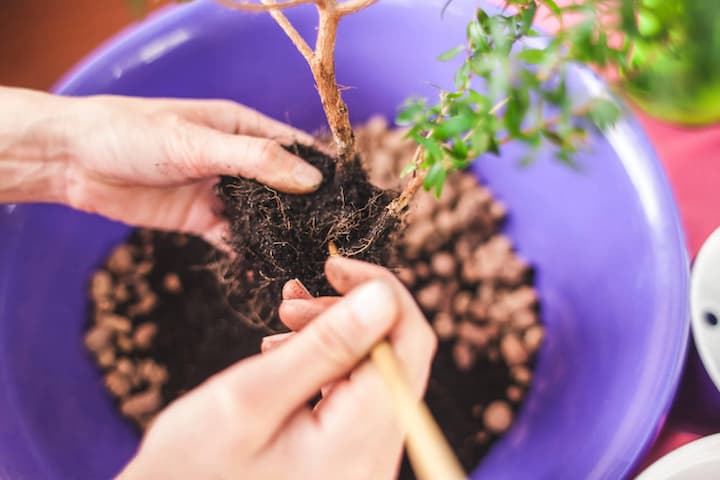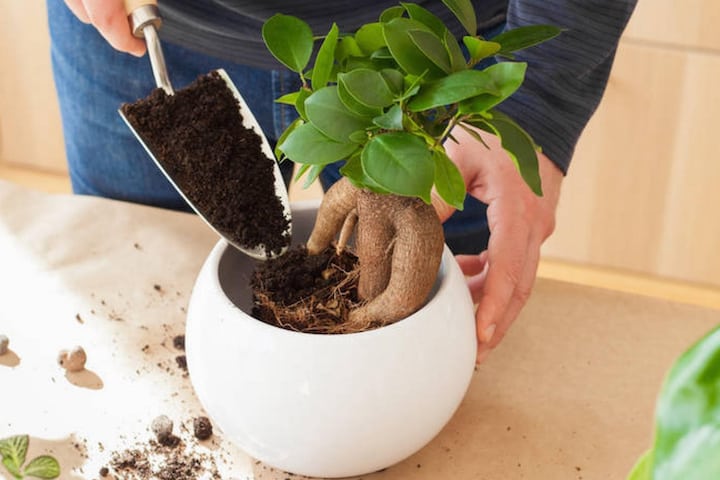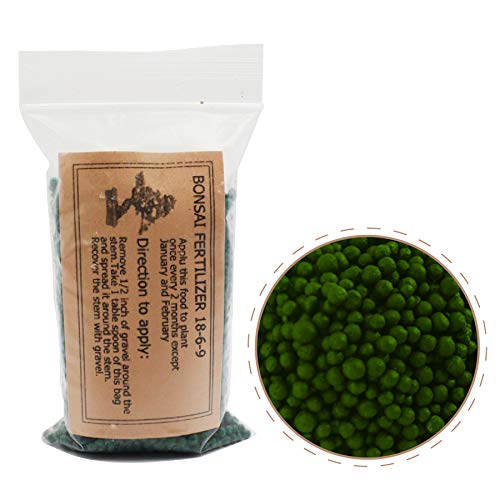Bonsai trees are beautiful plants that require special care and attention. They also take a long time to mature. If you want to start growing bonsai trees, then you should know the type of soil mix that they prefer.
Bonsai trees are prized for their unique shape and beauty. The roots of these trees are shallow and compact, which makes them ideal for growing in pots or containers, but they need good bonsai soil.
Good bonsai soil is able to provide rich nutrients, water absorption, provide aeration and allows for proper excess water drainage. Understanding what makes the best bonsai soil mixes is important for healthy bonsai trees.
This article will cover everything about bonsai soil composition and soil mixtures to help you understand the best bonsai soil available and what the bonsai soil requirements are.
Best Bonsai Tree Soil
Bonsai trees are dwarf trees and can be cultivated from any number of tree species. They live and thrive both indoors and outdoors, and will require a small amount of soil regardless of the environment they are raised in.
Selecting the correct kind of soil is fundamental because it will provide nourishment for your Bonsai tree. Most Bonsai soil does not contain actual soil.
Soil ingredients will be a mixture of different percentages of clay, rocks, and organic matter. Here are our recommendations for the best Bonsai Tree Soil and why we recommend them.
1. Boon Bonsai Soil Mix “Boon Mix”
The Boon Bonsai Soil Mix is the most common and widely accepted mix among bonsai masters and professional worldwide.
The name “Boon Mix” originates from Boon Manakitivipart, a big promoter of bonsai tree health in the United States.
The Boon Mix is made up of mostly non-organic soil components and considered real bonsai soil. There’s no bark, mulch, dirt, etc.
If garden soil dries out too quickly, it may become difficult for plants to grow properly. Bonsais don’t like dirt and they won’t survive if kept in soil for too long.
Boon Bonsai Soil Mix Pros
- Ready-to-Use out of the bag
- Good water drainage
- Good aeration for roots
- Pre-sifted before bagging
- Helps uptake of fertilizer
- Helps promote more beneficial bacteria
Boon Bonsai Soil Mix Cons
- Would prefer more Akadama in the mix to make it equally 1/3
2. Hoffman Bonsai 10708 Soil Mix
The Hoffman Bonsai Soil mixes pine bark, hydite, and sand pebbles in this premium Bonsai soil mix.
Professionally and perfectly formulated for excellent drainage, it also retains moisture for the health of your tree. This soil mix is especially appreciated by gardeners raising evergreen species of Bonsai trees.
This is a pre-mixed blend that is ready for immediate use in a convenient resealable bag.
Hoffman Bonsai 10708 Soil Mix Pros
- Hand-mixed
- Specially formulated for Bonsai trees
- Resealable bag for convenience
- Organic with nutrients and trace elements
- Great for evergreens
Hoffman Bonsai 10708 Soil Mix Cons
- Not aesthetically attractive
3. Birch Seeds All-Purpose Bonsai Tree Potting Soil
Formulated for all species of Bonsai trees, the Birch Tree Bonsai Potting Soil is an all-purpose blend of premium peat moss and perlite-based grit.
This is a fast-draining mix that also contains horticultural-grade sand and lime to ensure aeration of bonsai tree root systems together with Perlite.
Sold in a resealable bag it is ready-to-use and creates no hassles when you are ready to repot your Bonsai.
Birch Seeds Bonsai Tree Potting Soil Pros
- Premium and horticultural-grade components
- Resealable Easy-to-use bag
- Affordable for the quantity
- Formulated for all types of Bonsai trees
Birch Seeds Bonsai Tree Potting Soil Cons
- Some observations about water retention and drainage
4. Tinyroots Deciduous Bonsai Tree Soil Blend
The Tinyroots Deciduous Bonsai Soil Blend offers just about everything you can imagine for the care of your Bonsai tree.
This soil blend offers a hand-mixed, pre-sifted natural and organic Bonsai tree soil specifically formulated for Deciduous Bonsai trees like Elm or Maple.
The mix contains Akadama, coarse river sand, Frit, Turface, and very fine pine bark. Tinyroots has integrated 28 trace elements that are vital to your tree’s health.
Tinyroots does manufacture other soil mixes, including single substrates if you prefer to mix your own.
Tinyroots Deciduous Bonsoil Tree Soil Blend Pros
- Hand-mixed and pre-sifted
- Specially formulated for deciduous Bonsai trees
- Resealable bag for convenience
- Organic with nutrients and trace elements
Tinyroots Deciduous Bonsoil Tree Soil Blend Cons
- More expensive than other bonsai soil brands
5. Tinyroots Premium Bonsai Soil for Conifers
This two-quart/4 lbs. bag of all-natural and organic Tinyroots Premium Bonsai Tree Soil has been specially blended for Conifer Bonsai trees.
This soil blend is designed for the soil needs of Junipers, Black Pines, White Pines, Cypress, and Cedars trees, as well as other Conifers.
The Premium Bonsai Soil contains top-quality ingredients, including Akadama, Frit, Turface, and 28 vitamins and minerals for Conifer health. River sand and ground bark are also included for improved nutrition.
This is a ready-to-use blend for all of your repotting needs, offering both great drainage and moisture retention.
Tinyroots Premium Bonsai Soil Pros
- Hand-mixed and pre-sifted
- Specially formulated for Conifer Bonsai trees
- Resealable bag for convenience
- Organic with nutrients, vitamins, minerals, and trace elements
Tinyroots Premium Bonsai Soil Cons
- Expensive
6. Fujiyama All Purpose Bonsai Mix
The Fujiyama All Purpose Bonsai Mix is a premium Bonsai soil blend that works well with conifers, evergreens, or deciduous bonsai trees. It offers exceptional drainage and moisture retention, for thriving Bonsai.
The soil mix is formulated with both inorganic and organic soil components to ensure aeration of root systems and to avoid compacted soil.
Fujiyama offers various sized packages for sale, including 2, 4, 10, and 20-quart bags.
Fujiyama All Purpose Bonsai Mix Pros
- Premium Bonsai soil blend
- Exceptional drainage
- Good water retention
- Good aeration
- Various sized bags available for purchase
Fujiyama All Purpose Bonsai Mix Cons
- Not always in stock, so it can be hard to get your hands on.
Bonsai Soil Mix Guide
All the Bonsai soil mixes above that you can buy online or at garden centers are ready-mixed soils. Even though they are ready-to-go, it’s still important to understand things like the soil component to know what’s best for healthy Bonsai plant roots.
What Is Standard Bonsai Soil Made of?
The kind of Bonsai soil one chooses will depend to some extent on the species of Bonsai that you are cultivating. Basic standard Bonsai soil will be a mixture of substrates of clays, lava rock, organic matter, and pumice.
While Bonsai soils will vary from one brand to another, the basic ratio that is considered optimal for conifers is 1:1:1. That’s one part lava rock, one part pumice, and one part Akadama, a naturally occurring granular clay. Maple trees and deciduous trees, in general, do better with a 1:1:2 ratio.
Some brands will include peat moss and tree bark pieces in their mixes, but these components should be added prudence. There are exceptionally nutritious, but can impede soil drainage and correct root aeration.
Bonsai Soil Aeration
Bonsai tree roots require oxygen for vigorous root growth. If roots are packed within a standard dirt and compost soil mix, they will not have access to sufficient oxygen.
Loose Bonsai soil mix leaves room for the air to permeate and circulate, so that root systems benefit from proper aeration and little air pockets.
Bonsai Soil Drainage
Well-draining soil is crucial to the health of your Bonsai tree. If you plant your Bonsai in a container with standard garden soil and water it, moisture remains in the compact dirt soil. The Bonsai roots will gradually drown because they don’t have access to oxygen.
Most Bonsai species will not enjoy sitting in water, as this will lead to the tree’s roots rotting. Root rot left unattended will kill your tree.
Proper Bonsai soil will feature excellent drainage that allows any excess water to drain out of the bottom of the Bonsai pot after you have finished watering.
Bonsai Soil Water Retention
This may seem like a contradiction after having reiterated the need for great drainage, but it’s not.
The fact that your tree doesn’t want to sit in water, also known as “wet feet,” does not mean that it doesn’t need water. If your tree was planted in rocks or gravel alone, the water would drain out and none would remain, meaning the roots would not have access to the water they need to survive.
For this reason, Bonsai soil types include one or more ingredients that are water retentive. The granular natural clay known as Akadama, originating in Japan, is a popular solution for water retention when cultivating Bonsai trees. This substance is baked to provide a substrate that is similar to gravel.
Bonsai Soil Nutrients
Bonsai soil contains little or no organic matter, so it will also feature a very low amount of nutrients for your tree. For this reason, feeding your tree with fertilizer regularly is of the essence.
The three elements necessary for the nutrition of most plants are nitrogen, phosphorous, and potassium. You will need a Bonsai fertilizer with those ingredients to keep your tree thriving.
Bonsai fertilizers are available in pellet or liquid plant food form.
Bonsai Soil pH Levels
For most Bonsai trees, the soil pH level should measure between 6 and 6.5. If the pH is higher, the soil will have alkaline conditions. When pH is low, that’s acidic soil.
Proper Bonsai soil fertilization will not only provide necessary nutrients, but assist in balancing pH levels in the soil mix.
Alkaline trees are more common and is usually due to a lack of fertilization or lower water quality. A good Bonsai fertilizer that contains sulfur can aid in regulating pH levels. You can measure pH levels with a soil pH meter.
How Is Bonsai Soil Different?
Bonsai soil is different from normal potting soil and is not recommended for use with plants other than Bonsai trees. Soil structure and components are different to support strong root growth for Bonsai trees.
The Bonsai mix contains little to no soil. That helps keep the mix loose and roomy, so that there is good airflow around the roots. It helps the soil mix stay lightweight as opposed to heavy and is not compacted.
The typical Bonsai mix will contain a good amount of inorganic material such, as Diatomaceous earth or fired clay.
With houseplants, you need to provide nutrition, so organic soil and compost are preferable. In the case of Bonsai trees, inorganic materials are better.
Fired clay will not decompose or break down, so it provides the necessary amount of water retention but allows good drainage at the same time. Together with fired clay and Diatomaceous earth, you will often find perlite or vermiculite.
Would Succulent Soil Work Well for a Bonsai?
Yes, succulent soil also does not break down very easily and is usually quite porous, meaning that it will offer good water retention and drainage at the same time. These characteristics make succulent soil suitable for use with Bonsai too.
When mixed properly, it will offer sufficient nourishment for your Bonsai, just like any Bonsai soil mix. However, when cultivating a Bonsai, always research the species you are cultivating to make sure the soil mix you have meets nutrient requirements for your Bonsai tree.

How to Mix Your Own Bonsai Soil?
If you are passionate about your Bonsai care and like more control over growth, you can mix soil yourself for your Bonsai tree. There is no single soil mix recipe that will work for every Bonsai tree due to the difference in species of Bonsai trees.
However, there are standard basic materials used in Bonsai mixes and you will need to adjust the ratio of those ingredients to meet the needs of your specific type of Bonsai tree.
Below are various options you have when looking to make your own Bonsai soil mix.
Bonsai Substrates
You may already have some substrate on hand, if you purchased your Bonsai tree from a nursery. This would be ideal because they will already have the right mixture of soil and nutrients.
The basic materials used to DIY Bonsai soil mixes include:
- Akadama
- Conifer Bark
- Diatomite
- Lava Rock
- Moss
- Pumice
- River rocks
- Sand
- Turface
Keep in mind the ratio of components when mixing Bonsai soil. A 1:1:1 ratio should be used for conifer trees, while a 1:1:2 ratio should be used for deciduous and other tree types.
Remember when mixing that aeration, good drainage, and water retention make for a great Bonsai soil mix.
Every Bonsai gardener will create his or her special soil recipe a little differently. If you choose to mix your Bonsai soil, you will have your own recipes as well, as you strive to achieve the best soil mix for your specific tree, in its cultivation environment and climate.
Organic or Inorganic Bonsai Soils
Bonsai soil is generally divided into two classifications, inorganic and organic.
Inorganic Bonsai Soil
Inorganic Bonsai soil mixes use no organic materials whatsoever. It will offer no nourishment as a result, meaning that all nutrients will need to be furnished by fertilizer.
When a soil type is inorganic, three different types of inorganic substrate will be blended to create the inorganic Bonsai soil mix.
Organic Bonsai Soil
Organic soil mixes will contain organic materials like tree bark or peat. These organic components add nutrients to the soil mix, but can and will break down, leading bad drainage in the Bonsai pot.
For this reason, inorganic blends are more popular than organic soil for Bonsai plants.

Bonsai Soil Components
Typical materials that act as bonsai soil components include these:
Akadama
Akadama is a type of Japanese clay that retains water well. It is mined from the surface and then fired or baked. This results in hard material that will break down very slowly during the life of the soil mix blend.
Lava Rock
A porous volcanic rock, lava rock also provides water retention. The uneven surfaces of this rock also contribute to the development of Bonsai tree feeder roots.
Pumice
Another volcanic rock, pumice is lightweight and equally porous. It will retain some water, but is considered to be dryer than other materials. It is also very hard and will not break down.
Mixing ratios for inorganic Bonsai soil mix are 1:1:1 for pines, junipers, and other conifers. 1 part Akadam, 1 part lava rock, and 1 part pumice.
For deciduous trees like maples and elms, the ratio will be 2:1:1 – 2 parts Akadama, 1 part lava rock, and 1 part pumice.
Do Bonsai Trees Need Special Fertilizer?
Because Bonsai soil mixes are created with airflow and drainage in mind, nutritional needs come in a distant third and often nourishment is low. As such, Bonsai trees need to be fed regularly, particularly in the growing season.
What do you feed a Bonsai?
What nutrients to feed a Bonsai tree will depend on the species of tree and the season. All Bonsai tree fertilizers as houseplant fertilizers will have basic shared ingredients. Among these, you’ll find nitrogen, phosphorous, and potassium.
The fertilizer, and which plants it should be used for, will be defined by the amounts and ratio of these elements. This is known as the NPK ratio.
Bonsai trees that are being cultivated outdoors will be better served by a fertilizer with an NPK ratio of 10:6:6 (or 5:3:3). Bonsais living indoors can use a balanced 3:3:3 NPK ratio.
If your Bonsai experiences the seasons, you should decrease feeding at the end of the tree’s growing season during the winter. Increase feedings again when the growing season begins the next year in the spring.
If the tree type you choose is a tropical species that will grow all year, feeding should also be given year-round.
- Learn more about How to Overwinter Bonsai.
Bonsai Soil Mix Final Thoughts
Bonsai soil mix will distinguish itself from other soil mixes because of the exceptional drainage that it provides these dwarf trees. It also offers excellent aeration, yet still retains the necessary moisture for the tree to thrive.
Bonsai trees are benefitted by the inorganic materials found in these soil mixes for their ability to drain excess water. But these same characteristics that make this soil mix optimal for drainage, water retention, and aeration, also offer little or no nourishment to a Bonsai. As a result, your Bonsai will need regular feedings.
If you enjoy a gardening challenge, consider mixing your own Bonsai soil blend for your Bonsai tree.
Here are other Bonsai articles to help you on your Bonsai journey:













